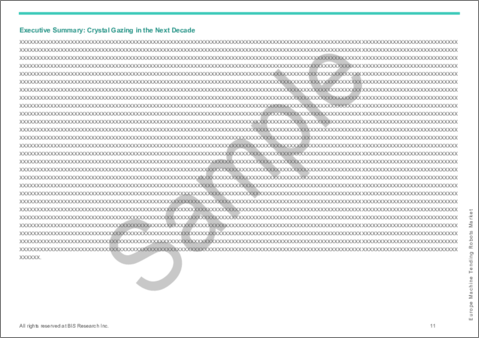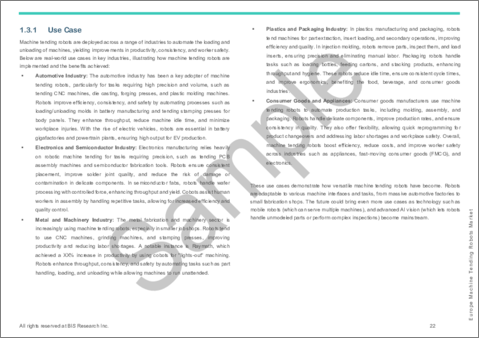|
|
市場調査レポート
商品コード
1748469
欧州のマシンテンディングロボット市場:用途別、最終用途産業別、ロボットタイプ別、国別 - 分析と予測(2024年~2034年)Europe Machine Tending Robots Market: Focus on Application, Product Type, Country Analysis - Analysis and Forecast, 2024-2034 |
||||||
カスタマイズ可能
|
|||||||
| 欧州のマシンテンディングロボット市場:用途別、最終用途産業別、ロボットタイプ別、国別 - 分析と予測(2024年~2034年) |
|
出版日: 2025年06月16日
発行: BIS Research
ページ情報: 英文 71 Pages
納期: 1~5営業日
|
全表示
- 概要
- 図表
- 目次
欧州のマシンテンディングロボットの市場規模は、2024年に17億5,071万米ドルとなりました。
同市場は、2034年には39億372万米ドルに達すると予測され、予測期間の2024年~2034年のCAGRは8.35%と堅調な伸びを示すとみられています。工場の生産性向上と運用コスト削減を目的とした自動化ニーズの高まりが、欧州のマシンテンディングロボット市場を牽引する主な要因となっています。繰り返し作業における精度と信頼性の向上への要求により、採用はさらに加速しています。労働力不足に対処し、製造工程を合理化するため、メーカーは高度なロボット工学に投資しています。さらに、センサーと制御技術の進歩により、より適応性の高いインテリジェントな機械加工ソリューションが可能になり、この地域の継続的な市場拡大を後押ししています。
市場イントロダクション
| 主要市場統計 | |
|---|---|
| 予測期間 | 2024年~2034年 |
| 2024年の評価 | 17億5,071万米ドル |
| 2034年の予測 | 39億372万米ドル |
| CAGR | 8.35% |
欧州のマシンテンディングロボット市場は、同地域の強固な製造基盤と自動化技術の採用増加により、急速に拡大しています。産業全体の生産効率、精度、安全性を向上させるため、CNCマシン、プレス機、射出成形システムなどの産業機器のロード、アンロード、操作を行うマシンテンディングロボットがますます不可欠になっています。需要は主に、正確さと一貫性が不可欠な自動車、エレクトロニクス、金属加工、プラスチック産業が牽引しています。
欧州ではインダストリー4.0とスマートファクトリープロジェクトに力を入れており、ロボティクスとデジタルシステムを統合してデータ主導のシームレスなオペレーションを実現しようとしているため、ロボティクスの導入が加速しています。特に注目すべきは、協働ロボット(コボット)の出現です。コボットは、安全上の重大な予防措置を講じることなく、人間のオペレーターと一緒に作業できる柔軟で安全な自動化を提供します。これにより、市場への浸透が促進され、中小企業(SME)の参入ハードルが低くなります。
人工知能(AI)、マシンビジョン、センサー統合の開発により、機械作業ロボットの能力は向上しています。これらの開発により、ロボットは複雑な作業をこなし、変化する生産需要に適応することができます。さらに、EUの厳格な安全基準や規制は、安全で信頼できるロボット操作を保証しており、採用者の信頼感を高めています。
初期コストの高さや労働力の再教育の必要性といった課題はあるもの、労働力不足の深刻化、賃金の上昇、欧州の製造業全体で自動化を支援する政府の優遇措置などを背景に、市場の見通しは依然として明るいです。
市場セグメンテーション
セグメンテーション1:用途別
- CNC機械加工
- 射出成形
- 研削・研磨
- 溶接
- 包装・仕分け
- その他
セグメンテーション2:最終用途産業別
- 自動車
- 電子・半導体
- 金属・機械
- プラスチック・包装
- 消費財・食品加工
- その他
セグメンテーション3:ロボットタイプ別
- 多関節ロボット
- 直交ロボット
- スカラロボット
- デルタロボット
- その他
セグメンテーション4:国別
- ドイツ
- フランス
- 英国
- イタリア
- ロシア
- その他
欧州のマシンテンディングロボット市場動向と促進要因・課題
市場動向
- 協働ロボットの統合:中小企業では、安全性、柔軟性、ケージなしで人間と一緒に作業できることから、協働ロボット(コボット)の採用が進んでいます。
- AIとビジョンシステムの採用:強化されたマシンビジョンとAIにより、ロボットはより高い精度と最小限のプログラミングで、複雑で変化しやすいタスクを処理できるようになります。
- 持続可能性の重視:リサイクル可能な素材を使用したエネルギー効率と耐久性に優れたロボットが、環境負荷の低減を目指すメーカーの注目を集めています。
市場促進要因
- 労働力不足:熟練労働者の減少や人件費の高騰により、製造業は反復的で危険な機械操作作業の自動化を進めています。
- インダストリー4.0の勢い:スマートでコネクテッドな工場の推進により、デジタル生産ラインにシームレスに統合する自動化システムの需要が高まっています。
- 政府の支援政策:地域プログラムは、製造オペレーションの近代化のためのインセンティブと資金を提供することにより、自動化を奨励しています。
市場の課題
- 高い資本コスト:ロボット工学と自動化インフラに必要な初期投資は、特に中小企業において採用を妨げる可能性があります。
- 統合の複雑さ:レガシーシステムや多様な生産環境にロボットを適応させるには、技術的な専門知識とカスタマイズが必要。
- 人材育成の問題:機械操作ロボットの導入が成功するかどうかは、ロボット・システムの操作、プログラム、保守を行う従業員を十分に再教育できるかどうかにかかっています。
製品/イノベーション戦略:製品セグメントでは、市場で入手可能な様々なタイプのロボットの包括的な概要を提供し、その独自の機能、性能特性、産業用途について詳述します。ロボットを多関節型、直交型、スカラ型、デルタ型、その他などのグループに分類することで、読者は各タイプが特定の操作要件にどのように対応し、製造効率を高めるかを把握することができます。このセグメンテーションは、最終的に欧州のマシンテンディングロボット市場における技術的多様性と競合情勢を理解するのに役立ちます。
成長/マーケティング戦略欧州マシンテンディングロボット市場では、事業拡大、提携、協働、合弁など、市場参入企業による主な開拓が見られます。各社が好む戦略は、欧州マシンテンディングロボット市場での地位を強化するためのパートナーシップ、コラボレーション、ジョイントベンチャー活動です。
競合戦略:本調査で分析・プロファイルした欧州マシンテンディングロボット市場の主要企業には、高度な自動化ソリューションや統合ロボットシステムを開発する企業が含まれます。分析では、ロボットのタイプ別市場セグメント、対応アプリケーション、地域プレゼンス、主要市場戦略の影響などを取り上げています。さらに、詳細な競合ベンチマーキングを実施し、競合企業の比較や市場情勢を明らかにしています。
当レポートでは、欧州のマシンテンディングロボット市場について調査し、市場の概要とともに、用途別、最終用途産業別、ロボットタイプ別、国別の動向、および市場に参入する企業のプロファイルなどを提供しています。
目次
エグゼクティブサマリー
第1章 市場:業界展望
- 動向:現状と将来への影響評価
- ロボット工学におけるAIとデジタル化
- 人間とロボットの協調と移動
- 自動化の民主化
- 研究開発レビュー
- 特許出願動向(国別・企業別)
- ステークホルダー分析
- 使用事例
- エンドユーザーと購入基準
- 市場力学の概要
- 市場の促進要因
- 市場の課題
- 市場の機会
第2章 地域
- 地域のサマリー
- 欧州
- 地域概要
- 市場成長促進要因
- 市場成長抑制要因
- ドイツ
- フランス
- 英国
- イタリア
- ロシア
- その他
第3章 市場-競合ベンチマーキングと企業プロファイル
- 今後の見通し
- 地理的評価
- 企業プロファイル
- Universal Robots A/S
- Staubli International AG
- Reis Robotics
- ABB
- KUKA AG
第4章 調査手法
List of Figures
- Figure 1: Europe Machine Tending Robots Market (by Region), $Million, 2023, 2028, and 2034
- Figure 2: Machine Tending Robots Market (by Application), $Million, 2023, 2028, and 2034
- Figure 3: Europe Machine Tending Robots Market (by End-Use Industry), $Million, 2023, 2028, and 2034
- Figure 4: Europe Machine Tending Robots Market (by Robot Type), $Million, 2023, 2028, and 2034
- Figure 5: Key Events
- Figure 6: Patent Filed (by Country), January 2021-December 2024
- Figure 7: Patent Filed (by Company), January 2021-December 2024
- Figure 8: End User and Buying Criteria
- Figure 9: Impact Analysis of Machine Tending Robots Market Navigating Factors, 2023-2034
- Figure 10: Germany Machine Tending Robots Market, $Million, 2023-2034
- Figure 11: France Machine Tending Robots Market, $Million, 2023-2034
- Figure 12: U.K. Machine Tending Robots Market, $Million, 2023-2034
- Figure 13: Italy Machine Tending Robots Market, $Million, 2023-2034
- Figure 14: Russia Machine Tending Robots Market, $Million, 2023-2034
- Figure 15: Rest-of-Europe Machine Tending Robots Market, $Million, 2023-2034
- Figure 16: Data Triangulation
- Figure 17: Top-Down and Bottom-Up Approach
- Figure 18: Assumptions and Limitations
List of Tables
- Table 1: Opportunities across Regions
- Table 2: Competitive Landscape Snapshot
- Table 3: Trends: Current and Future Impact Assessment
- Table 4: Stakeholder Analysis
- Table 5: Machine Tending Robots Market (by Region), $Million, 2023-2034
- Table 6: Europe Machine Tending Robots Market (by Application), $Million, 2023-2034
- Table 7: Europe Machine Tending Robots Market (by End-Use Industry), $Million, 2023-2034
- Table 8: Europe Machine Tending Robots Market (by Robot Type), $Million, 2023-2034
- Table 9: Germany Machine Tending Robots Market (by Application), $Million, 2023-2034
- Table 10: Germany Machine Tending Robots Market (by End-Use Industry), $Million, 2023-2034
- Table 11: Germany Machine Tending Robots Market (by Robot Type), $Million, 2023-2034
- Table 12: France Machine Tending Robots Market (by Application), $Million, 2023-2034
- Table 13: France Machine Tending Robots Market (by End-Use Industry), $Million, 2023-2034
- Table 14: France Machine Tending Robots Market (by Robot Type), $Million, 2023-2034
- Table 15: U.K. Machine Tending Robots Market (by Application), $Million, 2023-2034
- Table 16: U.K. Machine Tending Robots Market (by End-Use Industry), $Million, 2023-2034
- Table 17: U.K. Machine Tending Robots Market (by Robot Type), $Million, 2023-2034
- Table 18: Italy Machine Tending Robots Market (by Application), $Million, 2023-2034
- Table 19: Italy Machine Tending Robots Market (by End-Use Industry), $Million, 2023-2034
- Table 20: Italy Machine Tending Robots Market (by Robot Type), $Million, 2023-2034
- Table 21: Russia Machine Tending Robots Market (by Application), $Million, 2023-2034
- Table 22: Russia Machine Tending Robots Market (by End-Use Industry), $Million, 2023-2034
- Table 23: Russia Machine Tending Robots Market (by Robot Type), $Million, 2023-2034
- Table 24: Rest-of-Europe Machine Tending Robots Market (by Application), $Million, 2023-2034
- Table 25: Rest-of-Europe Machine Tending Robots Market (by End-Use Industry), $Million, 2023-2034
- Table 26: Rest-of-Europe Machine Tending Robots Market (by Robot Type), $Million, 2023-2034
- Table 27: Market Share, 2023
Introduction to Europe Machine Tending Robots Market
The Europe machine tending robots market, valued at $1,750.71 million in 2024, is expected to reach $3,903.72 million by 2034, exhibiting a robust CAGR of 8.35% during the forecast period 2024-2034. The growing need for automation to increase factory productivity and reduce operating costs is a major factor driving the machine tending robots market in Europe. Adoption is further accelerated by the requirement for increased accuracy and dependability in repetitive jobs. In order to address labour shortages and streamline manufacturing processes, manufacturers are investing in sophisticated robotics. Furthermore, more adaptable and intelligent machine tending solutions are being made possible by advancements in sensor and control technology, which is fostering the region's ongoing market expansion.
Market Introduction
| KEY MARKET STATISTICS | |
|---|---|
| Forecast Period | 2024 - 2034 |
| 2024 Evaluation | $1,750.71 Million |
| 2034 Forecast | $3,903.72 Million |
| CAGR | 8.35% |
The European Machine Tending Robots Market is expanding rapidly, owing to the region's strong manufacturing base and increased adoption of automation technology. In order to improve production efficiency, precision, and safety across industries, machine tending robots-which are made to load, unload, and operate industrial equipment like CNC machines, presses, and injection moulding systems-are increasingly essential. Demand is primarily driven by the automotive, electronics, metal fabrication, and plastics industries, where accuracy and consistency are essential.
Robotics deployment is accelerated by Europe's focus on Industry 4.0 and smart factory projects, as firms look to integrate robotics with digital systems for data-driven, seamless operations. Particularly noteworthy is the emergence of collaborative robots, or cobots, which provide flexible, safer automation that may operate alongside human operators without the need for significant safety precautions. This promotes wider market penetration and lowers the entrance hurdle for small and medium-sized businesses (SMEs).
Machine tending robots are becoming more capable thanks to developments in artificial intelligence (AI), machine vision, and sensor integration. These developments allow the robots to perform intricate jobs and adjust to changing production demands. Furthermore, strict EU safety standards and regulations guarantee safe and dependable robot operation, boosting adopters' confidence.
Despite challenges such as high initial costs and workforce reskilling requirements, the market outlook remains positive, driven by increasing labor shortages, rising wages, and government incentives supporting automation across Europe's manufacturing sector.
Market Segmentation:
Segmentation 1: by Application
- CNC Machine Tending
- Injection Molding
- Grinding and Polishing
- Welding
- Packaging and Sorting
- Others
Segmentation 2: by End-Use Industry
- Automotive
- Electronics and Semiconductors
- Metal and Machinery
- Plastics and Packaging
- Consumer Goods and Food Processing
- Others
Segmentation 3: by Robot Type
- Articulated Robots
- Cartesian Robots
- SCARA Robots
- Delta Robots
- Others
Segmentation 4: by Country
- Germany
- France
- U.K.
- Italy
- Russia
- Rest-of-Europe
Europe Machine Tending Robots Market Trends, Drivers and Challenges
Market Trends
- Collaborative Robot Integration: SMEs are increasingly adopting collaborative robots (cobots) for their safety, flexibility, and ability to work alongside humans without cages.
- AI and Vision Systems Adoption: Enhanced machine vision and AI enable robots to handle complex, variable tasks with higher precision and minimal programming.
- Sustainability Focus: Energy-efficient, durable robots made from recyclable materials are gaining attention as manufacturers seek to reduce environmental impact.
Market Drivers
- Labor Shortages: The declining availability of skilled workers and rising labor costs are pushing manufacturers to automate repetitive and hazardous machine tending tasks.
- Industry 4.0 Momentum: The push for smart, connected factories is increasing demand for automated systems that integrate seamlessly into digital production lines.
- Supportive Government Policies: Regional programs are encouraging automation by offering incentives and funding to modernize manufacturing operations.
Market Challenges
- High Capital Costs: The initial investment required for robotics and automation infrastructure can deter adoption, especially among smaller firms.
- Integration Complexity: Adapting robots to legacy systems and varied production environments requires technical expertise and customization.
- Workforce Training Gaps: Successful deployment of machine tending robots depends on adequately reskilling employees to operate, program, and maintain robotic systems.
How can this report add value to an organization?
Product/Innovation Strategy: The product segment provides a comprehensive overview of the various robot types available in the market, detailing their unique functionalities, performance characteristics, and industrial applications. Categorizing robots into groups such as articulated, Cartesian, SCARA, delta, and others enables readers to grasp how each type caters to specific operational requirements and enhances manufacturing efficiency. This segmentation ultimately aids in understanding the technological diversity and competitive landscape within the Europe machine tending robots market.
Growth/Marketing Strategy: The Europe machine tending robots market has seen major development by key participants operating in the market, such as business expansion, partnership, collaboration, and joint venture. The favored strategies of the companies have been partnership, collaboration, and joint venture activities to strengthen their position in the Europe machine tending robots market.
Competitive Strategy: Key players in the Europe machine tending robots market analyzed and profiled in the study include companies developing advanced automation solutions and integrated robotics systems. The analysis covers market segments by distinct robot types, applications served, regional presence, and the impact of key market strategies. Additionally, detailed competitive benchmarking has been conducted to illustrate how players compare, providing a clear view of the market landscape.
Key Market Players and Competition Synopsis
The companies profiled in the Europe machine tending robots market have been selected based on inputs gathered from primary experts and through an analysis of company coverage, product portfolio, application, and market penetration.
Some of the prominent names in this market are:
- Universal Robots A/S
- Staubli International AG
- Reis Robotics
- ABB
- KUKA AG
Table of Contents
Executive Summary
Scope and Definition
1 Market: Industry Outlook
- 1.1 Trends: Current and Future Impact Assessment
- 1.1.1 AI and Digitalization in Robotics
- 1.1.2 Human-Robot Collaboration and Mobility
- 1.1.3 Democratization of Automation
- 1.2 Research and Development Review
- 1.2.1 Patent Filing Trend (by Country and Company)
- 1.3 Stakeholder Analysis
- 1.3.1 Use Case
- 1.3.2 End User and Buying Criteria
- 1.4 Market Dynamics Overview
- 1.4.1 Market Drivers
- 1.4.1.1 Labor Shortages and Cost Pressures
- 1.4.1.2 Productivity, Throughput, and Quality Imperatives
- 1.4.1.3 Technological Advancements and Industry 4.0 Initiatives
- 1.4.2 Market Challenges
- 1.4.2.1 High Initial Investment and ROI Concerns
- 1.4.2.2 Technical Complexity and Skills Gap
- 1.4.2.3 Integration and Process Constraints
- 1.4.3 Market Opportunities
- 1.4.3.1 Untapped Industries and SMEs
- 1.4.3.2 Advancements in Technology and Service Models
- 1.4.3.3 Global Supply Chain Reconfiguration and Resilience Strategies
- 1.4.1 Market Drivers
2 Regions
- 2.1 Regional Summary
- 2.2 Europe
- 2.2.1 Regional Overview
- 2.2.2 Driving Factors for Market Growth
- 2.2.3 Factors Challenging the Market
- 2.2.3.1 Application
- 2.2.3.2 Product
- 2.2.4 Germany
- 2.2.4.1 Application
- 2.2.4.2 Product
- 2.2.5 France
- 2.2.5.1 Application
- 2.2.5.2 Product
- 2.2.6 U.K.
- 2.2.6.1 Application
- 2.2.6.2 Product
- 2.2.7 Italy
- 2.2.7.1 Application
- 2.2.7.2 Product
- 2.2.8 Russia
- 2.2.8.1 Application
- 2.2.8.2 Product
- 2.2.9 Rest-of-Europe
- 2.2.9.1 Application
- 2.2.9.2 Product
3 Markets - Competitive Benchmarking & Company Profiles
- 3.1 Next Frontiers
- 3.2 Geographic Assessment
- 3.3 Company Profiles
- 3.3.1 Universal Robots A/S
- 3.3.1.1 Overview
- 3.3.1.2 Top Products/Product Portfolio
- 3.3.1.3 Top Competitors
- 3.3.1.4 Target Customers
- 3.3.1.5 Key Personnel
- 3.3.1.6 Analyst View
- 3.3.1.1 Market Share, 2023
- 3.3.2 Staubli International AG
- 3.3.2.1 Overview
- 3.3.2.2 Top Products/Product Portfolio
- 3.3.2.3 Top Competitors
- 3.3.2.4 Target Customers
- 3.3.2.5 Key Personnel
- 3.3.2.6 Analyst View
- 3.3.2.7 Market Share, 2023
- 3.3.3 Reis Robotics
- 3.3.3.1 Overview
- 3.3.3.2 Top Products/Product Portfolio
- 3.3.3.3 Top Competitors
- 3.3.3.4 Target Customers
- 3.3.3.5 Key Personnel
- 3.3.3.6 Analyst View
- 3.3.3.7 Market Share, 2023
- 3.3.4 ABB
- 3.3.4.1 Overview
- 3.3.4.2 Top Products/Product Portfolio
- 3.3.4.3 Top Competitors
- 3.3.4.4 Target Customers
- 3.3.4.5 Key Personnel
- 3.3.4.6 Analyst View
- 3.3.4.7 Market Share, 2023
- 3.3.5 KUKA AG
- 3.3.5.1 Overview
- 3.3.5.2 Top Products/Product Portfolio
- 3.3.5.3 Top Competitors
- 3.3.5.4 Target Customers
- 3.3.5.5 Key Personnel
- 3.3.5.6 Analyst View
- 3.3.5.7 Market Share, 2023
- 3.3.1 Universal Robots A/S
4 Research Methodology
- 4.1 Data Sources
- 4.1.1 Primary Data Sources
- 4.1.2 Secondary Data Sources
- 4.1.3 Data Triangulation
- 4.2 Market Estimation and Forecast






